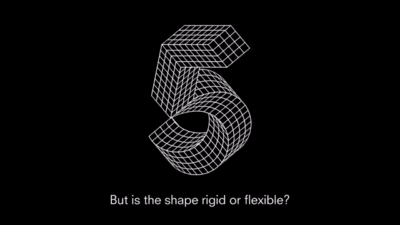
I invite everyone to familiarize themselves with the ten finalists of the 2020 annual optical illusion competition: a knife and a fork, a Soviet pencil case (tactile illusion), a mirror for vampires, ladybugs, a double staircase, an eversion mesh, fake sunbeams, an X-ray on the knee, raised subtitles.
A channel in the Cognitive Illusions telegram , where I will share the most disheveled findings on how to hack the brain through perception.
1st place: 3D Schroeder ladder
Kokichi Sugihara “3D Schröder Staircase”. Meiji University, Japan
The traditional Schroeder staircase is a two-dimensional picture that has two interpretations: the staircase seen from above and the staircase seen from below, and the second interpretation can be easily perceived if the picture is turned upside down.
The 3D object also has two interpretations, both of which are stairs seen from above, and the interpretations switch from one to the other when we rotate the object 180 degrees around the vertical axis.
2nd place: The real thing
Matt Pritchard “The Real Thing ??”. United Kingdom
I wonder if this can be done with a person? There would be a brain explosion! It's also a cool idea to make a "mirror" that reflects everything except the person in front of it.
3rd place: Impossible grid typography
Daniël Maarleveld. “Impossible grid typography“. The Netherlands
4th place: Ladybugs
Mark Wexler, Patrick Cavanagh, and Stuart Anstis. “Landloping ladybugs: Frame-induced position shift”. CNRS and Université de Paris, York University, and University of California at San Diego. France, Canada, and USA.Instead of seeing objects in their absolute position, we perceive where they are in relation to other visual cues.
5th place: Sunbeam illusion
Michael Karlovich & Pascal Wallisch “The Sunray Illusion”. New York University USA
In the image, you can see "rays from the center", similar to the sun's rays.
The illusion is heightened if the shapes have more intersection points and if they are better aligned, which allows our brains to "connect the points" that the rays produce.
6th place: X-ray
Kento Imai and Kenri Kodaka “XRAYSCOPE”. Nagoya City University, Japan
Augmented reality with a mirror and a flashlight. Creates the illusion of X-ray vision.
7th place: Illusion of subtitles
Masashi Atarashi “Subtitles Illusion”. Gojo high school Japan
Subtitles move at different speeds. Those subtitles that move faster seem closer to the viewer.
8th place: the illusion of a transparent knife
Blaise Balas and Benjamin Balas “Transparent Knife Illusion”. Benjamin Franklin Middle School and North Dakota State University, USA
Simple knife, simple fork. We stick the knife into the fork and it looks transparent.
9th place: Tactile illusion of tapioca
Aya Nishii, Masaki Ohno, Masashi Nakatani “The Tapioca Tactile Illusion”. Keio University, Japan
If you make a round hole in a piece of cardboard, squeeze it on both sides with your fingers, twist and move it, then you will feel like a rubber ball.
I had a Soviet retractable pencil case with a hole, so I felt this illusion in the first grade, because there was nothing to do in class.

10th place: Illusion of foggy contours
Russell D. Hamer and Christopher W. Tyler "Illusory 'Misty' Contours". Florida Atlantic University, Smith-Kettlewell Eye Research Institute, and City University of London, USA and UK
The task of vision is to recreate a 3D picture from two-dimensional data. The brain operates with perceptual "units", and not separate elements, because of this there is an illusion that the fog is on top of the image.
The post is written in part based on the materials of the American non-profit organization Neural Correlate Society Illusion of the Year.
The channel on Cognitive Illusions telegrams , where I will share the most disheveled findings on how to hack the brain through perception.